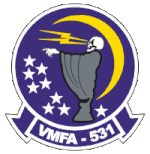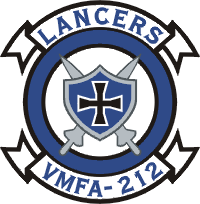
Marine Fighter Attack Squadron 212 (VMFA-212) was a United States Marine Corps F/A-18 Hornet squadron. Most recently known as the "Lancers", the squadron was last based at Marine Corps Air Station Iwakuni, Japan and fell under the command of Marine Aircraft Group 12 (MAG-12) and the 1st Marine Aircraft Wing. VMFA-212 has an extensive combat history having participated in combat operations during World War II, the Korean War, Vietnam War, the Gulf War, and Operation Enduring Freedom. Due to a re-organization within Marine aviation, the squadron was deactivated in 2008.

Marine Fighter Attack Squadron 323 (VMFA-323) is an aircraft carrier-based aviation squadron of the United States Marine Corps. The squadron is equipped with the McDonnell Douglas F/A-18C Hornet and is based at Marine Corps Air Station Miramar, California, United States. It falls under the command of Marine Aircraft Group 11 (MAG-11) and the 3rd Marine Aircraft Wing but deploys with the U.S. Navy's Carrier Air Wing 17 (CVW-17). Their tail code is WS and their radio callsign is Snake.

Marine Fighter Attack Squadron 122 (VMFA-122) is a United States Marine Corps fighter attack squadron flying the F-35B Lightning II. The squadron is based out of Marine Corps Air Station Yuma, AZ and falls under the command of Marine Aircraft Group 13 (MAG-13) and the 3rd Marine Aircraft Wing. The squadron nickname is the "Flying Leathernecks," and their traditional radio call sign is "Nickel". On November 14, 2017, VMFA-122 opened a new chapter of their history, transitioning from the McDonnell Douglas F/A-18C Hornet to the Lockheed Martin F-35B Lightning II and moving from MCAS Beaufort and MAG-31, 2nd MAW to MCAS Yuma and MAG-13, 3rd MAW.

Marine Fighter Attack Squadron 333 (VMFA-333) was a United States Marine Corps fighter squadron consisting of F/A-18 Hornets. Known as the "Fighting Shamrocks" and “Trip Trey”, the squadron participated in action during World War II, the Vietnam War and Operation Desert Storm The squadron’s aircraft were easily recognizable by the row of three shamrocks painted on the vertical stabilizers of their aircraft. They were decommissioned on 31 March 1992.

Marine Fighter Attack Training Squadron 502 (VMFAT-502) is a United States Marine Corps fighter attack training squadron flying the Lockheed Martin F-35 Lightning II. Known as the "Flying Nightmares", the squadron maintains the history of Marine Attack Squadron 513 (VMA-513) which dates back to World War II and was decommissioned on 12 July 2013. The squadron is based at Marine Corps Air Station Miramar and falls under the command of Marine Aircraft Group 11 and the 3rd Marine Aircraft Wing

Marine Aircraft Group 11 is a United States Marine Corps aviation unit based at Marine Corps Air Station Miramar that is currently composed of two F-35C squadrons, one F-35B squadron, two F/A-18C squadrons, one fleet replacement squadron, one KC-130J tactical aerial refueling squadron, a maintenance and logistics squadron, and a wing support squadron. They fall under the command of the 3rd Marine Aircraft Wing and the I Marine Expeditionary Force.

Marine Fighter Attack Squadron 115 (VMFA-115) is a United States Marine Corps F/A-18 Hornet squadron. Officially nicknamed the "Silver Eagles" and on occasion Joe's Jokers after their first commanding officer Major Joe Foss, the squadron is based at Marine Corps Air Station Beaufort, South Carolina and falls under the command of Marine Aircraft Group 31 (MAG-31) and the 2nd Marine Aircraft Wing. The squadron has seen combat during World War II, the Korean and Vietnam Wars and has deployed in support of Operation Iraqi Freedom with a final deployment in 2008 to Al Asad Airbase in western Iraq. The Squadron radio callsign is "Blade".

Marine Fighter Attack Squadron 542 (VMFA-542) is a United States Marine Corps Aviation fighter attack squadron transitioning to the F-35B Lightning II. VMFA-542 is based at Marine Corps Air Station Cherry Point, North Carolina and falls under the command of Marine Aircraft Group 14 (MAG-14) and the 2nd Marine Aircraft Wing.
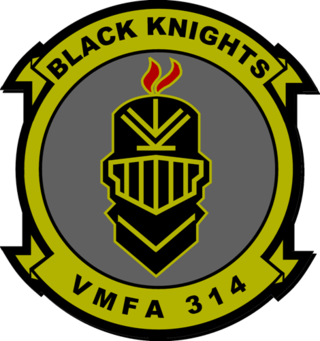
Marine Fighter Attack Squadron 314 (VMFA-314) is a United States Marine Corps F-35C Lightning II squadron. The squadron, known as the "Black Knights", is based at Marine Corps Air Station Miramar, California and falls under the command of Marine Aircraft Group 11 (MAG-11) and the 3rd Marine Aircraft Wing, but deploys with the US Navy's Carrier Air Wing Nine (NG).
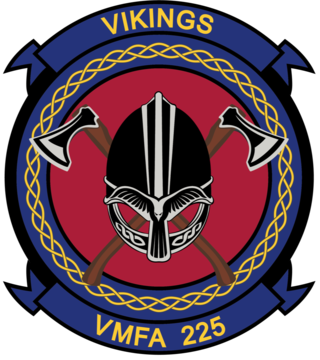
Marine Fighter Attack Squadron 225 (VMFA-225) is a United States Marine Corps fighter attack squadron flying the F-35B Lightning II. The squadron, known as the "Vikings", is based at Marine Corps Air Station Yuma in Arizona and falls under the command of Marine Aircraft Group 13 (MAG-13) and the 3rd Marine Aircraft Wing.
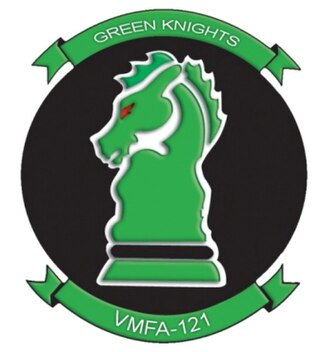
Marine Fighter Attack Squadron 121 (VMFA-121), also known as the "Green Knights", is a United States Marine Corps aircraft squadron operating the F-35B Lightning II. The squadron is based at Marine Corps Air Station Iwakuni, Japan and falls under the command of Marine Aircraft Group 12 (MAG-12) and the 1st Marine Aircraft Wing. Their tail code is VK and their radio call sign is "Combat".

Marine Aircraft Group 31 (MAG-31) is a United States Marine Corps aviation group based at Marine Corps Air Station Beaufort, South Carolina that is currently composed of two F/A-18C Hornet squadrons, one F/A-18A++ Hornet squadron, two F/A-18D Hornet squadrons, one F-35B Lightning II training squadron, and an aviation logistics squadron. It falls under the command of the 2nd Marine Aircraft Wing.

Marine Fighter Attack Squadron 312 (VMFA-312) is a United States Marine Corps F/A-18C Hornet squadron. Also known as the "Checkerboards", the squadron is based at Marine Corps Air Station Beaufort, South Carolina and falls under the command of Marine Aircraft Group 31 (MAG-31) and the 2nd Marine Aircraft Wing. The Radio Callsign is "Check."

Marine Aircraft Group 41 (MAG-41) is a United States Marine Corps reserve aviation unit based at Naval Air Station Joint Reserve Base Fort Worth, Texas that is currently composed of one F/A-18C squadron, one KC-130J squadron, one C-40 squadron, one Northrop F-5 aggressor squadron based at Marine Corps Air Station Yuma, Arizona, one Marine Light Attack Helicopter Squadron at MCAS Camp Pendleton, one MV-22B squadron based at MCAS Miramar, one aviation logistics squadron and two wing support squadrons with multiple detachments throughout the United States.
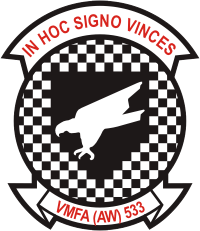
Marine All-Weather Fighter Attack Squadron 533 is a United States Marine Corps F-35B squadron. Also known as the "Hawks", the squadron is based at Marine Corps Air Station Beaufort, South Carolina and falls under the command of Marine Aircraft Group 31 (MAG-31) and the 2nd Marine Aircraft Wing.

Marine Fighter Attack Squadron 235 (VMFA-235) was a United States Marine Corps squadron that most recently flew F/A-18 Hornets. Known as the "Death Angels", the squadron participated in action during World War II, the Vietnam War, Operation Desert Storm and was decommissioned on June 14, 1996.

Marine Fighter Attack Training Squadron 501 (VMFAT-501) is a training squadron in the United States Marine Corps, consisting of 27 F-35B Lightning II aircraft and serves as the Fleet Replacement Squadron. Known as the "Warlords," the squadron is based at Marine Corps Air Station Beaufort, South Carolina and falls administratively under Marine Aircraft Group 31 and the 2nd Marine Aircraft Wing. The squadron has assumed the lineage of VMFA-451 which was originally known as the “Blue Devils” and saw action during World War II and Operation Desert Storm. They were decommissioned on January 31, 1997.

Marine Fighter Attack Squadron 334 (VMFA-334) was a United States Marine Corps fighter squadron. Known as the “Falcons”, it was part of Marine Aircraft Group 15 and Marine Aircraft Group 33. The squadron participated in action during World War II and the Vietnam War and was decommissioned in 1971.
Marine Aircraft Group 53 (MAG-53) was a United States Marine Corps night fighter training group that was commissioned during World War II. It was the first night-fighter group in the Marine Corps. During the course of the war the group trained eight night fighting squadrons and sent seven of them into combat. The group was decommissioned after the war during the post-war drawdown of forces.

The VMF(N)-531 GCI Detachment was a short lived aviation command and control unit that was part of the United States Marine Corps's first night fighter squadron, VMF(N)-531. This detachment was the Marine Corps' first dedicated GCI detachment utilized in a combat zone. In the early phases of World War II the Marine Corps did not have stand-alone early warning and ground-controlled intercept (GCI) units so these capabilities were initially placed in the headquarters of each Marine Aircraft Group and with individual night fighter squadrons. The detachment was deployed in the South Pacific from August 1943 through August 1944 and was responsible for the interception of numerous Japanese aircraft. Lessons learned from this deployment were instrumental in establishing tactics and procedures for the Marine Corps' newly established Air Warning Program. Upon returning from its first and only deployment, the detachment was dissolved and its members went on to serve as instructors at the 1st Marine Air Warning Group, which was responsible for training new squadrons. Many of them later served in leadership roles in these Air Warning Squadrons as they supported follow on combat operations.
